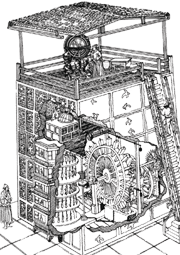E-Archive
Off the Beaten Track
in Vol. 10 - September Issue - Year 2009
Time Passages

The women and children had been sent away several days earlier and the men now worked feverishly as they loaded their last belongings on the few horses which were still available, piling everything on the poor animals’ backs until it seemed that furniture, baskets and horses would all topple under the weight. The advancing Tartar troops were only a few miles away and would soon cut off the last escape route out of the city.
As he looked around to make sure that nothing had been forgotten, the young man glanced at the large wooden tower which loomed silently a short distance from where he was standing. As he had done so many times in the past, he admired the birds, the trees and the stunning array of gold stars on a deep blue sky which had been painted with such breathtaking detail on the outer walls of the tower. He had been one of the assistants entrusted with maintaining the marvelous mechanism hidden inside the construction and he felt deep pain at the thought of having to abandon it to the invaders. As if responding to his thoughts, the tower’s bells started chiming. It would be the last time the young man heard them ring. He turned his back and joined the stream of fugitives escaping from the city.
********
It is not known when and where mechanical clocks were invented, since none of the historical documents give technical details and it is impossible to know whether anything referred to as a “clock” was mechanical or simply a water clock. Falling or running water had been used to power various agricultural and metallurgical machines since thousands of years earlier, but by the first centuries A.D., there was a growing need to have a more reliable and accurate means of keeping time compared to the water clocks which had been used up to then. This requirement grew stronger also because of the desire to carry out certain religious functions in the prescribed manner, based on the exact time of the day. For this reason, waterpower had started to be applied in Europe and in Asia, especially in China, to drive mechanized astronomical instruments and finally timekeepers.
In China, a series of successive developments over the years culminated in the construction of a forty-foot-tall wooden tower clock in Khaifeng, capital of the Northern Sung dynasty, in the year 1090 A.D. This work was the creation of Su Sung, who first built a wooden model and then cast the working parts in bronze. The machine was moved by carefully-controlled waterpower. A reservoir supplied a constant flow of water which powered a waterwheel, which in turn moved an endless chain connected to a series of gears and wheels. At the heart of this marvelous instrument was one of the world’s first escapement mechanisms, which kept the various devices in the tower moving at an even pace thanks to a complex arrangement of balances, counterweights and locks. A celestial globe and an armillary sphere slowly turned at the speed of one revolution per day, while a series of shafts, gears and wheels worked bells and drums which announced the time. The escapement divided the flow of the water into equal parts by repeated weighing and by dividing the revolution of the wheel into equal intervals.
The construction ran into trouble about forty years later, when the Chin Tartars conquered Khaifeng in 1126, destroying the tower but saving the clock, which they later installed in Peking, the Chin capital.
In the meantime, the Sung rulers had set up court in a new territory and they tried to build another clock, but could not do so because they had not been able to take with them the drawings and the secret of the escapement mechanism when they fled Khaifeng. Chroniclers reported the consternation and the sadness which overtook the royal court when it was realized that Su Sung’s marvelous construction could not be duplicated.
But what happened to the clock which had been carried away by the Chin Tartars? Again, more invasions and more sad twists to the story. The clock was left behind when the Chin court fled from the Mongols in 1264 and it was finally destroyed when the Ming dynasty captured Peking in the fourteenth century.
Thus the pioneering technology of Su Sung’s tower clock was lost forever and would not be seen again until the seventeenth century, when missionaries brought European mechanical clocks to China.
By Giovanni Gregorat, Contributing Editor MFN & Sales Manager, Pometon Abrasives
Author: Giovanni Gregorat



























